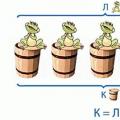Variations in the use of cards for learning colors. Why do we teach colors to children?
With my youngest son, I study colors using the “100 colors” set from the Umnitsa company. All their colors are divided into 10 main categories: red, orange, yellow, green, blue, purple, white, gray, black and brown. It was these ten primary colors that I prepared my cards for. If someone doesn’t have the “100 flowers” set, you can cut out such pictures yourself from colored cardboard measuring 7*10 cm.
While reading the poem, I place a color card under the stencil pictures. The game is fast and fun. You can also play with stencil cards in another way - apply them to any objects - children really like this game!
 How I did it.
How I did it.
I printed the cards on matte photo paper with a density of 160. (When printing from a file, select “borderless” in the settings so that everything fits on the sheet). Then, using a stationery knife and nail scissors, I cut out what would be a window that would be interesting to show in color. After that I laminated everything. I did this at home. Stationery stores sell sheet sets of 100 sheets of A-4 format for laminate. They can be easily processed with an iron. (It may be a little expensive, but it will definitely last for a long time. And now I’m doing a lot of things for the child). My density is not more than 150 microns (2*75). You put a white sheet of paper, then a sheet of cards in the film, then another white sheet and iron it at medium temperature. The film changes color from matte to transparent and becomes denser. After laminating, I cut out the cards with a utility knife and the corners with nail scissors. I put everything in a tea box.
First, you can introduce the basic colors, and then even these same picture cards are suitable for introducing the shades from the “100 colors” set. For example, cherry - cherry, wave - aqua, milk - milk, chocolate - chocolate, etc.
Here you can download a PDF document with all 119 cards.
This is the second part of the article on the topic “Doman Methodology. Our review”, but you can read the first one here:
A few secrets to successful card demos
- To ensure that the child’s interest in classes does not fade away, it is very important to promptly remove well-studied cards from the set being viewed and replace them with new ones. With my daughter, I noticed that if the number of views of a card reaches a certain number of views (and as training progresses, this number decreases all the time), it becomes uninteresting to her: the daughter begins to be distracted when it appears and does not look very carefully. But as soon as you show the new card, she looks, hypnotized, greedily absorbing new information, soaking in every detail. Therefore, it is very important to monitor the child’s reaction to the cards; viewing should always be dynamic, the child should not get bored.
- There should be no distractions during flashcard demonstrations. If during our demonstrations someone walks nearby or makes sudden movements, if there is a TV or radio nearby or some noise is heard, it is better to immediately interrupt the demonstration, because There is no point in continuing it - the daughter cannot really concentrate.
- There is no point in inviting your child to view cards if he is interested in some kind of game. . No matter how many times I made similar attempts, they were never successful - my daughter either looked at the cards reluctantly or completely ignored the display. Our best demonstrations are tied to certain routine moments, for example, when sitting on a potty, before or after meals, etc.
What to do if your child has lost interest in the cards?
During our more than 1.5-year training using Doman cards, my daughter mostly looked at the cards with pleasure. But, I must admit, there were also times when she did not want to see them at all. I think all mothers who practice the Doman technique sooner or later encounter this problem. According to my observations, the best thing to do in this case is:
- Do not put pressure on your child to look at the cards. so as not to completely discourage him from practicing according to the method. I think this rule applies to any developmental activities - the more pressure you put on a child with an offer to exercise, the greater the protest that arises in the child’s soul.
- Update several cards in a set, or completely replace the entire set . In my experience, this method is the most effective and here’s why: the child loses interest in the cards either because he has already learned them too well, or because he is not interested in the topic itself. It happens that a child is simply not interested in watching boring vegetables, but he will look at animals or sights of the world with pleasure.
- Interrupt training according to the method for several days . After some time, resume the show and observe the reaction. The pause may need to be extended a little. But just don’t give up on your studies!
- Seek help from your favorite toys and friends. Before viewing the cards, you can sit dad, a bear, a doll and other friends next to your baby; it’s more fun to watch together. Another option is for the bear to show the cards to the baby. And finally, for older children, another option is for the child to show the cards to his toy friends (the mother, of course, prompts).
- When it comes to learning to read, the methods described above may not help and in this case the best help various word games . Many examples of games can be found.
I should note that now that my daughter is already 2 years old, we get to look at the cards less often. Now she is more often busy with her own games and activities, it has become more difficult to distract her, and the crisis age is making itself felt.
How we studied colors using Doman cards
Learn colors using Doman cards ( BUY, DOWNLOAD) we tried to start several times. The first time was when Tasya was 8 months old. The attempt ended in complete failure. Despite the fact that at that time it was a great pleasure for my daughter to look at other sets of cards, she looked at the cards with flowers as if I were showing her blank sheets. At first I couldn’t understand why Taisiya had no interest in them at all, and only then I learned that children begin to distinguish colors at about 10 months.
I decided to make a second attempt when my daughter was just over a year old. This time she began to peer at the cards with interest and, as it seemed to me, remember the names of the colors. But when I began to slowly replace the cards and include such exotic colors as “pink”, “lilac”, she again lost interest. The impression was that the daughter does not distinguish them, but recognizes only the primary colors.
And I made the third attempt when I realized that my daughter’s color perception was working perfectly. This was at the age of 1 year 4 months, by this time Taisiya already knew well and showed the four primary colors - red, yellow, blue, green. Then I again took out a set of “colored” cards. We studied the entire set again and now it was absolutely clear that my daughter understood and remembered everything. Since then, in our communication, we began to constantly use the names of new colors - such as crimson, light green, pink, etc. My daughter recognized and showed all these colors. I think that without Doman cards we would hardly be able to learn 18 colors so easily in 1 year 4 months!
A small note. It is best to learn only those colors that you yourself distinguish and whose names you are really ready to use in your games and conversations. There is no point in learning, for example, the color purple if, having met it in life, you will most likely call it purple. This will only confuse the child.
How we studied forms using Doman cards

When Tasya was not even one year old, during our games or drawing, I always tried to use the names of the three main ones in conversation - square, circle, triangle. I just named them, and, to be honest, I didn’t think that my daughter had already learned them. Therefore, I was very surprised when, one year ago, I asked her to answer where which figure was, and she showed everything without hesitation. Then I decided it was time to study a more complete set geometric shapes and took out a set of Doman’s “Forms” cards ( BUY, ).
We quickly learned 20 geometric shapes (even such as parallelogram, rhombus, trapezoid) and began to use them in our games so as not to forget. In particular, we drew them together, with geometric shapes.
Perhaps showing cards with geometric shapes could have started earlier; I think the child would have learned everything. But since I am of the opinion that any knowledge gained from cards is best consolidated during other games, I believe that we would hardly have succeeded in this before a year.
Doman cards and speech development
And finally, a small addition.
In addition to the previously mentioned positive results from training using the Doman method, I also noticed that training using the Doman method greatly contributes. While looking at the cards, my daughter always wants to reproduce what she heard. When Taisiya was about a year old, she tried, at least in monosyllables, to repeat after me the name of the picture she saw, or to depict it (for example, she snorted at the sight of a hedgehog, or pointed to a specific object). A little older, she began to repeat all the words in their entirety. Well, now, when Taisiya listens to whole fact-sentences, she easily remembers them and then gives them to us.
By the way, in the original version of Doman’s technique, such repetition of words by a child while watching is not encouraged. According to Doman, the baby should see the card for about 1 second, and if he repeats the word, the viewing will obviously take longer. I think it is precisely because of such limitations, which turn viewing into a mechanical process, that Doman’s technique has so many opponents. We have chosen for ourselves a teaching method without such restrictions. It's up to you to decide which method you choose.
Well, that’s it, I wrote my review about the Doman method. Are you already practicing this method with your baby or are you just looking at it? If you are still undecided, I advise you to read the article
Here we offer you to download free color pictures, 32 in total. The educational material, in addition to the basic colors of the rainbow, as well as pink, white, black, gray and brown, contains various variations of the color scheme: beige, scarlet, purple, pistachio, lilac, burgundy, khaki, indigo, etc.
The technique developed by Glen Domana allows you to conduct classes with a child from a very early age. Best time for a child to assimilate educational material from birth to 3 years of age, it is during this period of a person’s life that the brain actively grows and develops. Then the ability to learn decreases.
How to learn colors using Glen Doman's flashcards
First, of course, show your child cards with primary colors: red, purple, orange, blue, yellow, cyan, green, brown, white, black. Name each color and show it to the child for 5-10 seconds. Over the course of several lessons, study only these colors until the child learns them all.
In the future, add several new colors to your study. Using these cards, your child will learn all the colors very quickly.
Classes according to Doman cards They perfectly develop the child’s visual memory, attentiveness, and speech. This is a great exercise for the mind.
You can download and print everything for free Doman color cards.
Right-click on the card and click “Save Image As...” so you can save the image to your computer.
How to make Doman cards yourself:
Print the cards on thick paper or cardboard, 2, 4 or 6 pieces per sheet. To conduct classes using the Doman method, the cards are ready, you can show them to your child and say the name of the picture.
These Doman cards will help you quickly learn all the colors with your child.
Good luck and new discoveries to your baby!

Educational cards using the Doman method - color pictures for children

Educational cards using the Doman method - color pictures for children

Educational cards using the Doman method - color pictures for children

Educational cards using the Doman method - color pictures for children


Educational cards using the Doman method - color pictures for children

Educational cards using the Doman method - color pictures for children

Educational cards using the Doman method - color pictures for children

Educational cards using the Doman method - color pictures for children

Educational cards using the Doman method - color pictures for children

Educational cards using the Doman method - color pictures for children

Educational cards using the Doman method - color pictures for children

Educational cards using the Doman method - color pictures for children

Educational cards using the Doman method - color pictures for children

Educational cards using the Doman method - color pictures for children

Educational cards using the Doman method - color pictures for children

Educational cards using the Doman method - color pictures for children

Educational cards using the Doman method - color pictures for children

Educational cards using the Doman method - color pictures for children

Educational cards using the Doman method - color pictures for children

Educational cards using the Doman method - color pictures for children

Educational cards using the Doman method - color pictures for children

Educational cards using the Doman method - color pictures for children

Educational cards using the Doman method - color pictures for children

Educational cards using the Doman method - color pictures for children

Educational cards using the Doman method - color pictures for children

Educational cards using the Doman method - color pictures for children

Educational cards using the Doman method - color pictures for children

Educational cards using the Doman method - color pictures for children

Educational cards using the Doman method - color pictures for children

Educational cards using the Doman method - color pictures for children
More of our Doman cards using the “Prodigy from the Diaper” method:
- Domana Cards Tableware
Glen Doman is an American neurophysiologist, author of a method of intellectual and physical education of children from the moment of birth. It was he who said: “Every child can become a genius, and early development is the key to his genius.”
Doman developed his own system of pedagogical techniques, methods and criteria for comprehensive education. Part of this technique is training cards. With their help, you can significantly expand your child’s vocabulary and even teach him to read.
If the baby sees the words written on the cards and at the same time hears their pronunciation, then his brain understands and mechanically remembers it.
How to study with cards correctly?
Classes are best carried out starting from the age of 6 months. Every day, show your child the cards one after another, starting with five, gradually increasing the number by 3 pieces. Be sure to pronounce the names of words clearly.
We develop from an early age!
In this set you will find 12 cards. They are double sided. On one you will see geometric shape, and on the other - color. All names are written in red, as expected according to the Doman method. Show your child pictures and pronounce the names so that he can better assimilate the information.
What is inside:
- 12 cards;
- leaflet with information for parents.
Also in the series of educational cards you will find the following topics:
- "Alphabet from A to Z";
- "Wild animals";
- “Animals of hot countries”;
- "Pets";
- "Vegetables";
- "Professions";
- "Bird of Russia";
- "Transport";
- "Fruits".
 Concept of inequality, related definitions
Concept of inequality, related definitions Tactics of medieval battles
Tactics of medieval battles Ace pilot Kozhedub Ivan Nikitovich - three times hero of the USSR
Ace pilot Kozhedub Ivan Nikitovich - three times hero of the USSR